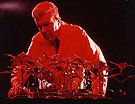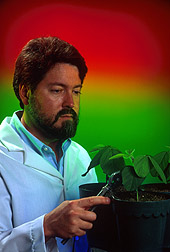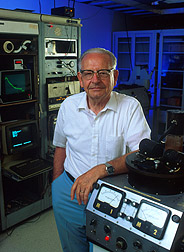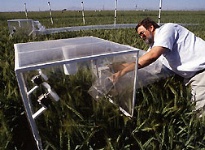Tripping the Light Switch Fantastic
|
|
In 1918, a pair of U.S. Department of Agriculture scientists in northern Virginia asked two simple questions, launching an intellectual voyage still far from over. Their discoveries were the prelude to the search for what would prove to be one of nature's most important light switches. During the years 1936 to 1959, a dozen scientists at USDA's research center in Beltsville, Maryland, pursued and finally forced their quarry, phytochrome, into the daylight. Today we know that phytochrome is a dual-form plant protein. It is switched back and forth by red light and by far-red, a zone at the horizon of our eyes' visual limits. By this transformation, phytochrome ordains whether a plant will start, or put off, making flowers. And in the next season, phytochrome wakens seeds to germinate or prolongs their sleep. Skeptics, who reasonably believed phytochrome an illusion, dubbed it a “pigment of the imagination.” Ironically, imagination was the key to unveiling phytochrome. It showed itself in clues the scientists saw in phytochrome's reflected reality—the measured life cycle of plants. |
|
View related stories: Enzymes Give Plants UV Protection |
Balky Tobacco, Bullheaded Soybeans The search began in 1918. Why, wondered botanist Harry A. Allard and physiologist Wightman W. Garner, did Maryland Mammoth tobacco not know when to stop making leaves and start making flowers and seeds? The tobacco, first noticed in 1906, seemed a boon to growers. It grew as tall as 15 feet and put out nearly 100 leaves until frost would kill it. But what good was this oddity? It rarely flowered in Maryland, and it never produced seed in the field that could be used to plant the next crop. Its tantalizing ability to produce leaves seemed a mirage. And why, Garner and Allard puzzled, were soybean farmers being frustrated at spreading out their harvest time? They would plant the crop 2 weeks apart, but the plants would all set flowers at the same time. The two researchers solved both mysteries with the same experiment. In retrospect, the test seems so simple it might have sprung from the naive fancy of a child—except no one had tried it before. In July 1918, Allard and Garner grew some Biloxi soybeans and Maryland Mammoth in pots. Some plants they left outside all day long. But every afternoon, they placed one group in a shed without windows, returning them outdoors the next morning. The tobacco flowered 3 months earlier; the soybeans, 5 weeks earlier. Thus was born the concept of photoperiodism—an organism's response to the relative lengths of night and day. At the time, the light/dark ratio lay mostly unexplored, an oddity in the standard explanation that plants grew and developed by laws of soil, climate, and the total amount of light they received. The two USDA scientists soon found that different plants had different kinds of photoperiods. Maryland Mammoth and Biloxi soybeans, as well as chrysanthemums and others, flower in reply to the shortening days of late summer. Lettuce, spinach, and the like are long-day early summer—flowerers. And day-neutral plants like tomatoes and dandelions flower right up until frost. People didn't wait to learn what made photoperiodism work; they used it. Florists, no longer chained to a plant's outdoor season, began growing flowers indoors year round, serving each type the ration of light it needed to yield flowers. Plant breeders came out with crop varieties suited to day length, as fixed by the angle that a given latitude presented to the sun during a given season. Seed of Maryland Mammoth was successfully grown in Florida, where the plant flowered and set seed in the state's brief, mild days of winter. It would take 41 years to isolate phytochrome—to get, in the words of Sterling B. Hendricks, “a bottle of the stuff” that was the trigger for photoperiodic response. |
|
|
Night Lightening In l936, with little fanfare, USDA established a tiny research project on photoperiodism at its sprawling research center in Beltsville. Botanist Harry A. Borthwick—heading the project—and physiologist Marion W. Parker were unsatisfied with using the conspicuous arrival of flowers as a meter of photoperiodism. Instead they examined “primordia.” These microscopic bodies emerge as the first visible signs of flowers. They quickly discovered that only 2 “short” days—when nights were as long as 10-1/2 hours—made Biloxi soybeans produce primordia 5 days later. Shortly thereafter, they found that this flowering could be prevented if a single, 30-second burst of light butted in on the long night. How could something so seemingly trivial—hardly enough light to wake a sleeping child—halt a plant's charge toward reproduction? Again there was no answer, but breeders and horticulturists quickly enjoyed savings on light bills for their greenhouses. Instead of leaving the lights on for several hours each night to create a short night, they used a few minutes of light to get the same result. At the time, the major focus of photoperiodism studies was to look for some kind of signal—perhaps a hormone—that travels from a plant's leaves to its fast-growing tips. But about 1940, Borthwick and Parker saw that they should home in on the leaf's interplay with light itself. About leaves, they knew much; they needed someone who knew about light. |
|
|
The Disguise Takes on Color They sought out Hendricks, a Beltsville colleague. An expert mountain climber, Linus Pauling's first grad student, and a brilliant chemist, Hendricks was one of the first Americans to use x-rays to study molecular structure. The trio knew their quarry had to be a substance that could detect whether light was present. So it must be a pigment. But sunlight comes in a spectral stew of visible and invisible tints. Which color ingredient energized their phantom pigment? And how could they find it? Theoretically, the solution was simple. Just as water droplets carve the sun's rays into an arching rainbow, the scientists used a prism to filter light into its separate facets. Hendricks knew how spectrographs worked and how to tinker with them. But most spectrographic work dealt with purified material, not the queer confederacy of solids and liquids that makes up leaves. Further, the light intensities used in spectrographs were small—designed for the needs of photographic film, not living plants. Finally, the spectra would have to be spread over a wide area; the researchers would gain nothing if several colors fell on the same leaf. The solution was a $50 experiment so elegant no large-scale research effort would ever have devised it. Their huge, lO-kilowatt carbon arc-light was “cadged from a Baltimore movie theater, with memories of pulchritude,” Hendricks reported later. And somehow he obtained two large prisms, which were already historic. They'd been used by Samuel Pierpont Langley. Astronomer, physicist, and aeronautics pioneer, Langley had died in 1906. For their test, light passed through the prisms to cast its spectrum 42 feet away, in a 7-foot swath, across 14 soybean plants at a time. Several groups of plants had been grown on 16-hour days to prevent flowering; each plant had been stripped of all but one leaf—the youngest mature one. When the test began, the scientists cut the plants' ordinary light exposure to 10 hours a day, which normally would induce flowering. But in the middle of the dark period, they turned on the spectral array for periods of 1 to 25 minutes. After 6 days, they returned all the plants to long photoperiods. A week later they checked for primordia. The fewer the primordia, the greater the effect of specific light spectra on the pigment. With this test, the pigment surrendered the first solid clue to its color. Since the plants responded most strongly to red and yellow light, the pigment must be absorbing these hues. And that meant the active form of the pigment had to be blue or green. This conclusion, obvious to any student of light, may not be clear to a lay reader. Any color that we see is made up of some combination of any or all of the red, yellow, green, and blue zones of the visible spectrum. Like a selective mirror, a colored substance reflects only what it cannot absorb. So something—like phytochrome—that absorbs only reds and yellows will reflect blue and green. In 1948, tests with barley—a long-day species—proved that the same pigment governed flowering in long-as well as short-day plants. This too was exciting, but a couple of years later the outlook seemed clouded. The spectrograph tests were important, but also awkward, imprecise, and time consuming. Next to the spectrograph room was a doorway that would lead Hendricks, Borwick, and Parker to faster progress. |
|
|
Red and Far-Red Switchcraft The door belonged to the Seeds Investigations Laboratory. There, the husband-and-wife team of Eben H. and Vivian K. Toole had for years been looking into why some seeds, like lettuce, need light to germinate. Some 15 years earlier, physiologist Lewis H. Flint, another researcher in the lab, and E.D. McAlister of the Smithsonian Institution had set about finding that, indeed, germination was promoted most by red light. Maybe that would be useful, Eben Toole mentioned to the photoperiodism group sometime in 1951 or 1952. Would it ever! Experiments would take days instead of weeks. Moisten the seed for 16 hours, hit it with red light, then watch for germination in a few days. Further, Flint and McAlister had seen something intriguing about far-red light and germination. Far-red light not only failed to promote germination; it stalled it. Hendricks, Borthwick, and Parker hadn't seen this—but it would also turn out to be true—in flowering. Discovering that far-red and red somehow foiled one another was critical in all further work to get a grip on the pigment. On April 9, 1952, the loose-knit team of scientists came up with another magnificently simple find. Seed hit with red light germinated unless it was then hit with far-red; but if red again ensued, it would germinate. Incredibly, all that mattered was which color came last even if the seed was struck by 100 alternating cycles of red and far-red. That summer, the researchers confirmed the same switchability in flowering. Test plants flowered only if far-red light ended the sequence. While fascinating, these discoveries gave the team no hard facts about the pigment's chemistry or its levels inside leaves. But they had reasoned this out: Their studies showed the pigment was probably blue or green and far more strongly colored than chlorophyll. There was another clue: albino barley plants, while responsive to their light tests, showed no blue tinge. That meant the pigment's concentration was minuscule. To cause such dramatic effects on plants, the stuff had to be some kind of catalyst. That, they surmised, meant it was an enzyme—and therefore a protein. Still, though they could measure what the receptor protein did in plants, they couldn't detect it in a test tube. And virtually no one else was doing this kind of work; literature searches circled them back to what they had published themselves. By 1953, Flint and Parker had left the team. But Borthwick, Hendricks, and the Tooles were soon joined by two physiologists, Albert A. Piringer and Robert J. Downs. Then, around I956, a third phase of informal collaboration with colleagues led the team to one final breakthrough. |
|
A Bottle of the Stuff Agricultural engineer Karl H. Norris, who at the time headed up a USDA Agricultural Marketing Service lab, had worked for about 10 years on nondestructive ways to gauge the quality of produce. To do this, he'd adapted several spectrophotometers so they would measure typical patterns of light absorption by goods such as eggs and apples. Ordinarily, these gadgets required material that was nearly transparent. Joining Norris in l956 was biophysicist Warren L. Butler; 1957 saw the final ingredient added, when Borthwick brought aboard Harold W. Siegelman, horticulturist turned biochemist. That same year, the project receive its first-ever operating budget, when Borthwick's lab was named one of ARS' two Pioneering Research Laboratories—the other being Hendricks' mineral nutrition lab. The basic idea was to use the spectrophotometer to tally changes in light absorption by plant tissue that held the pigment protein. The researchers knew that red changed the protein into a form sensitive to far-red. So, that form (which turned out to be green pigmented) should absorb more far-red light than red. And vice versa: Far-red light should make the now red-sensitive (blue) form of the protein absorb more red than far-red. For 2 more years, the team tried tissues from various plants: lettuce, cocklebur, albino barley, and the like. None worked. In mid-June 1959, Hendricks showed up in Butler's lab with dark-grown turnip seedlings for the spectrophotometer. “To our amazement and delight, mixed with skepticism,” Butler later reported, “we found that the difference spectrum between the red and far-red irradiated sample was precisely that predicted for phytochrome by the physiological action spectra” the scientists had been charting for years with Hendricks' large spectrograph. Within 2 hours, Siegelman tried the technique with a sample of ground-up turnip seedling. It retained the red/far-red reversibility. He then boiled a sample and tested it: no reversibility. This agreed with the prediction that the receptor was a protein, now destroyed by boiling. |
|
|
Officially Named The following April, the stuff in the bottle had its official name, a borrowed one combining the Greek words for plant and color. Butler suggested it half-jokingly, according to Borthwick. Phytochrome, which had once referred to all visible plant pigments, now named a dual-form protein—green in its red-sensitive form, blue when sensitive to far-red. Later that summer, Hendricks was invited to speak in Montreal at the Ninth International Botanical Congress. He suggested Butler run a demonstration after his talk. Norris produced a portable photometer, rigged to a wall-clock-size meter. In repeated trials in Beltsville, the meter's dial swung reliably between its 9-o'clock and 3-o'clock positions each time a sample was alternately beamed with red and far-red light. With high confidence, Hendricks, Butler, and Siegelman set off by car for Montreal. Unfortunately, they did not yet know that the far-red form of phytochrome is unstable once red light produces it in a seedling. This insight came too late to prevent their Montreal demonstration from becoming a dud. Whenever the three scientists stopped for gas during the drive to Canada, someone would check the trunk to make sure the corn seedling samples were okay. But opening the trunk let in huge doses of red light, converting the red-absorbing form of the protein into the wobbly, far-red form. By the time they got to Montreal, the seedlings didn't hold enough phytochrome to nudge the photometer dial by one whit. “However,” Butler remembered later, “in spite of the failure, the audience appeared to be kind and accepting and even to believe that we probably had achieved what we claimed.” Since 1959, phytochrome has continued to resist scientific prying. Not until 1983 was a reliable means developed to purify the protein in a fully intact form. It's still unclear where phytochrome resides in cells and exactly how it throws its genetic and behavioral switches in a plant. It's not even absolutely settled whether the far-red-sensitive form of phytochrome is an enzymatic protein. A catalyst, yes, but not all catalysts are enzymes. Phytochrome, like some other plant proteins, may have a different way of filling its role as a biochemical amplifier. In addition to phytochrome, scientists have uncovered two or three other classes of photoreceptors, such as those that absorb blue light and possibly even ultraviolet light. Researchers today continue gathering and sifting clues that may open up secrets of phytochrome and other photoreceptors for human advantage. What may emerge could be new strategies to control weeds, to make better use of a crop plant's preference for certain shades of light, and to use biotechnologies to improve one plant by borrowing the genetic light switch from another. Such stories cannot yet be written in full, but their outlines are being imagined.—By Jim De Quattro, ARS. |





